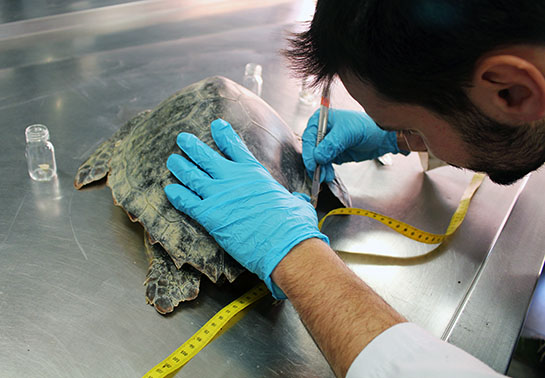A research of the Universitat de València calls on the proposition of the loggerhead turtle as an indicator of the pollution in the Mediterranean
- Fundació Parc Científic
- February 18th, 2019

A team of the Cavanilles Institute of Biodiversity and Evolutionary Biology carries out the first long-term research on litter in Mediterranean ingested by the loggerhead turtle (Caretta caretta). This work has contributed to the proposal of this species as an indicator of pollution through the EU’s Marine Strategy Framework Directive.
Sea litter, in particular, plastic waste thrown in the sea coming from human activities is one of the main threats to marine ecosystems. Many vertebrates are affected by this increasingly evident situation, which is compromising their ecosystems and, therefore, their biodiversity. Sea turtles ingest human litter, since they believe it is actual food. In severe circumstancies, the waste can even block or remove their alimentary tract causing death.
A research carried out by the Cavanilles Institute of Biodiversity and Evolutionary Biology (ICBiBe), located in the science and technology park of the Universitat de València, counted the level of waste ingested by loggerhead turtle that have been collected over 20 years (1995-2016) in the Mediterranean sea. This work, which had shown results over this period, has contributed to the proposal by the EU’s Marine Strategy Framework Directive of the Caretta caretta as an indicator of pollution of the Mediterranean, a sea almost enclosed by land with a high-rate demography, mainly in the coast, and one of the most polluted seas in the world.
The Marine Zoology Unit (UZM) in collaboration with the Agricultural, Environmental, Climate Change and Rural Development Ministry of Valencian Regional Government have coordinated for more than three decades the Care for Cetaceans and Sea Turtle Stranding Network of the Valencian Community. ‘This has allowed the valuable extraction of temporary series of data, leading to long-term research related to biology and the conservation of native species’, says Jesús Tomás, researcher of the UZM and coordinator of the European project INDICIT for the Mediterranean Spanish coast. This project assesses the litter impact in sea turtles and biota in The Atlantic and Mediterranean seas. ‘This research carried out for more than a decade has allowed to detect changes on the biology of these species as well as to identify and observe the evolution of different threats affecting them’, he adds.
The consideration of the loggerhead turtle as omnivorous, which implies a higher probability of ingesting waste, makes this species an excellent candidate to monitoring sea litter. According to the UZM, ‘this species feeds on many invertebrates and vertebrates such as jellyfish, pelagic tunicates and different fishes and cephalopods rejected by fishermen. Almost any element found in the water column can be considered as a potential prey for the loggerhead turtle, including of course floating waste’, explains J. Tomás.
The last research updates of this team have been recently punlished in the journal Environmental Pollution (Elvesier), and they conclude that the macroplastics intake has slightly decreased over the last decade in the Valencian coast. ‘This could be caused by a change in their habitat and diet – since they have started to frequent coastal zones – rather than a real decrease of sea waste’, points our Francesc Doménech, the first author of this research article published in Environmental Pollution.
Apart from the sea turtle, the UZM of the Universitat de València is also studying the presence and the effects of microplastics in dolphins and other fishes. The UZM has coordinated the European project INDICIT over the Spanish Mediterranean and it has also participated in the project INTERREG MEDSEALITTER on the standarisation of the different waste sampling and quatifying techniques in the Mediterranean.
Reference: Two decades of monitoring in marine debris ingestion in loggerhead siga turtle, Caretta caretta, from the western Mediterranean. F.Domènech, F.J.Aznar, J.A.Raga, J.Tomás. Environmental Pollution, 244: 367-378
More information:
File in: Ciencias de la Vida















